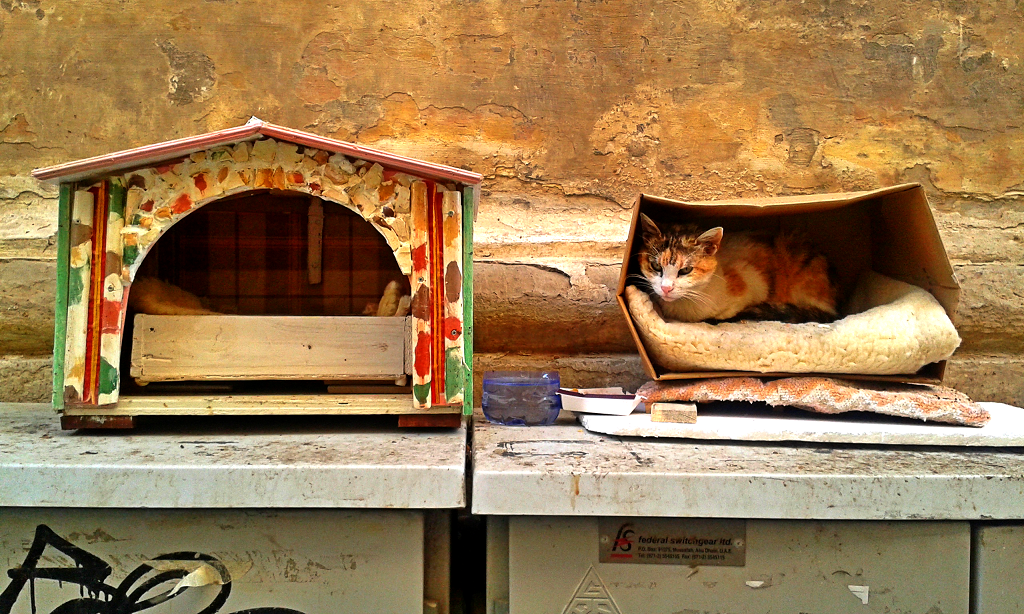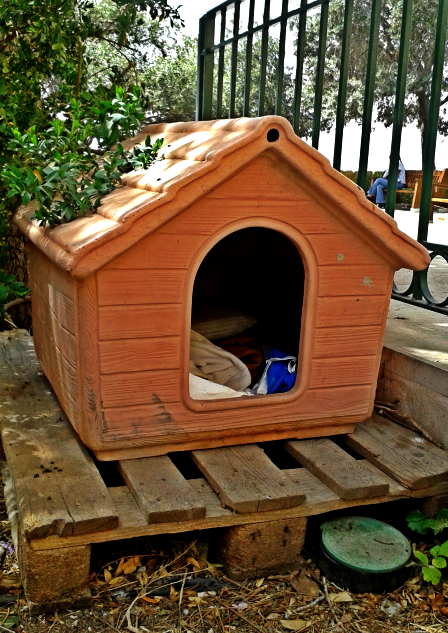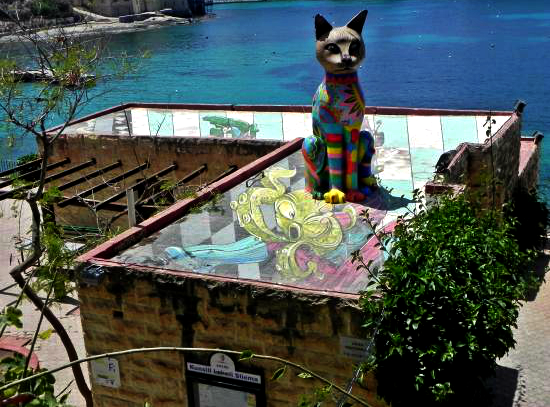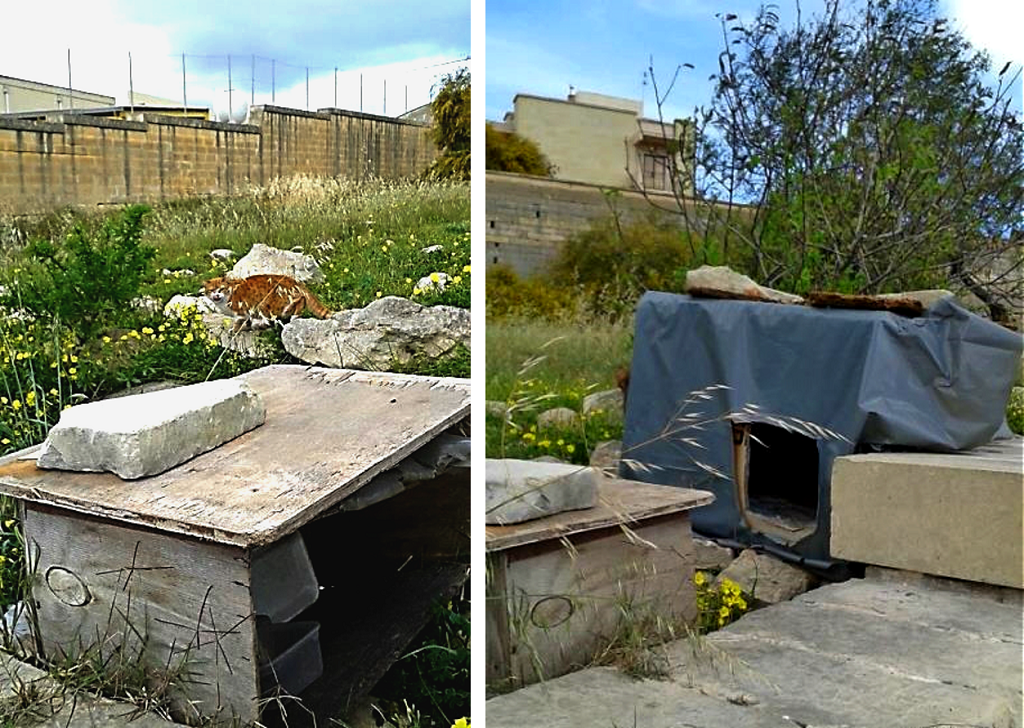
How could it be that a nation of ‘ambivalent Europeans’, which is hostile to migrants, can carve out pockets of compassion and kindness towards stray cats?
by Rachael Scicluna
Photographs by the author
[dropcap]A[/dropcap]lthough Malta is my birth home, having been away for nine years and coming back felt like I was rather an informed tourist with enough local knowledge, than a local myself. Like in other Mediterranean countries, stray cats are a kind of a permanent feature on window sills, resting under trees and slowly crossing busy roads. They are generally fed daily by the neighbours. But what caught my attention were these self-made cat homes. They were not as common back when I lived here. I believe there is a paradox here. Why? Well, as Malta becomes a popular destination with European and third country nationals, I often hear the Maltese complain that they feel the pressure of not being a homogeneous society. At times, this causes hostility and discrimination towards the unknown.
But how could it be then, that a nation of ‘ambivalent Europeans’ and which is hostile to migrants, can carve out pockets of compassion and kindness towards stray cats? Let me explain.
To understand this paradox, we need to contextualise Malta in a national and international scenario. There are two important intertwining forces at play which need to be untangled in order to understand this paradox – the social and economic spheres. Both are having an impact on our homes and families. Change is always intrinsically embedded in any culture, which is part of a larger process of a changing society. Here, what I would like to bring out is the way people engage with such forces in creative ways. However, first, it is important to understand how the social and economic forces are changing our society and households.
Nowadays, one cannot think of the Maltese household from a traditional perspective. Alternative family formations are more common due to racially mixed unions, same-sex couples and families, the rise of divorce and separations. Divorce and separations are leaving their mark on the Maltese household, often leading to inter-generational homes and reconstituted families living in rented accommodation. It is important to state that mixed unions are often considered to be important indicators of social integration of immigrants, as well as potential factors of social and cultural change. Such changes should not be demonised but instead one should zoom out and try to understand where our society is heading, through the way that people are creatively engaging with such institutional changes.
Another important factor which is also contributing to our changing society is the relationship between migration and the economy. This inflow of migrants from Europe and beyond – due to wars, political unrest and austerity – is generally having an impact on our society, especially the housing market and the private rented sector. Malta’s unprecedented economic boom has attracted migrants from all socio-economic backgrounds, with some even crossing borders with empty pockets and making use of emergency shelters. Others are being absorbed by the gaming and aviation sectors. This wave of migration has put pressure on our private rented sector (PRS) which was largely non-existent till a few years ago.
In the past, this phenomenon of renting was associated with the ‘poor’. This is mainly due to the difficulties in accessing adequate housing in a society where 80% of the population are homeowners. A welfare state, like that of Malta which is firmly based on kinship and the transfer of patrimonial assets may, in fact, be of little relief to migrants, especially those seeking a home in the private rented sector. The PRS in Malta is unregulated. The housing market generally favours the homeowner instead of the tenant. However, it is important to understand that the face of the tenant has changed as the middle class person (both foreign and Maltese) is seeking to rent a home in the 21st century.
In fact, I discovered the first Facebook Tenancy Support Group in Malta about two years ago. The founder of this support group explained that, as a returned migrant after living in Britain for over twenty years, she was to realise that her family was put on the highest utility rates. This was due to the fact that their rented property was the landlord’s second home – a summer residence. Hence, they were being billed the domestic tariff instead of the correct residential tariff, the latter being over 30% more expensive in respect of water and electricity consumption tariffs. The landlord refused to compensate the financial damage and did not change the residence status in order to continue avoiding paying more taxes. This ethnographic encounter shows the difficulties that many migrants face as they relocate to Malta and seek to make a home. The anxious Facebook feeds in this Tenancy Support Group do not cease. Discrimination against non-residents from unfair or no contracts, discriminatory home loans to being harassed by landlords when asked about domestic rates on utility bills are all common topics on this Facebook chat.

Amidst this tense climate in the PRS, especially shared households (a largely a new trend in Malta), these cat homes which resemble doll’s houses that children tend to play with at home, are on the rise. There seems to be a gradual transformation of the urban environment as more of these cat homes pop up in the most unusual of places. In fact, the images below were taken just on the outskirts of an industrial estate in San Gwann. Walking through this estate can be dangerous, as cars rush past in full speed and there are hardly any pedestrianized areas. However, everyday there is clean water and food in this make-shift cat home. Someone found the time to build a home for a ginger cat.
And what about the cat-doll’s-houses that feature in the images above? Are we witnessing a spill-over of the nineteenth century domestication process of pets from the home to public spaces? Is this part of the domestication of nature that needs to be tamed? Or are these cat homes pockets and acts of kindness in an urban context which can at times be harsh to migrants seeking to make a home?

Think of the huge monument of the one-eyed cat at the roof top of Independence Sliema Gardens and how the gardens have been transformed to accommodate the cats’ needs. Surely, the symbolic power of the home and housing is strong enough as it can be seen from these anthropomorphized cat dwellings. But after all, don’t we all need a home?

![]()
This article originally appeared on the author’s personal blog.

For a lot of people, African and other immigrants in Malta are worth much less than cats. They are in fact considered worthless by many, expendable and easily forgotten at best, disposed of in any way at worst. Just read the many hate-filled comments (some verging on incitement to violence or even criminal in content) which you can find below any story which has to do with immigrants, asylum seekers or refugees in Malta. Just a brief example of this: Yesterday I was greatly impressed by all the insults hurled at all those which had anything to do with the recent opera ‘Ahna Refugjati’. Unfortunately the fact that there are many people loving cats in Malta does nothing to mitigate or lessen all the hate that is being fanned in Malta against immigrant foreigners.